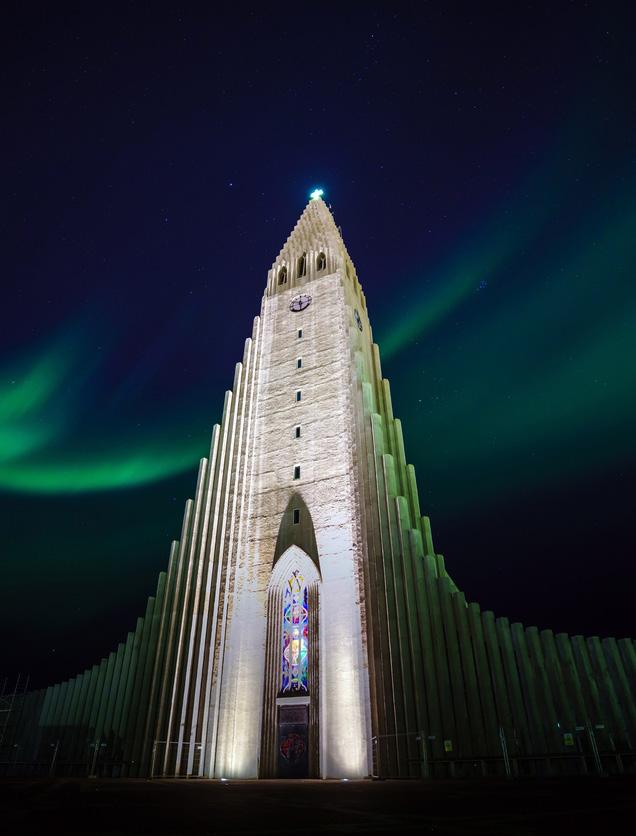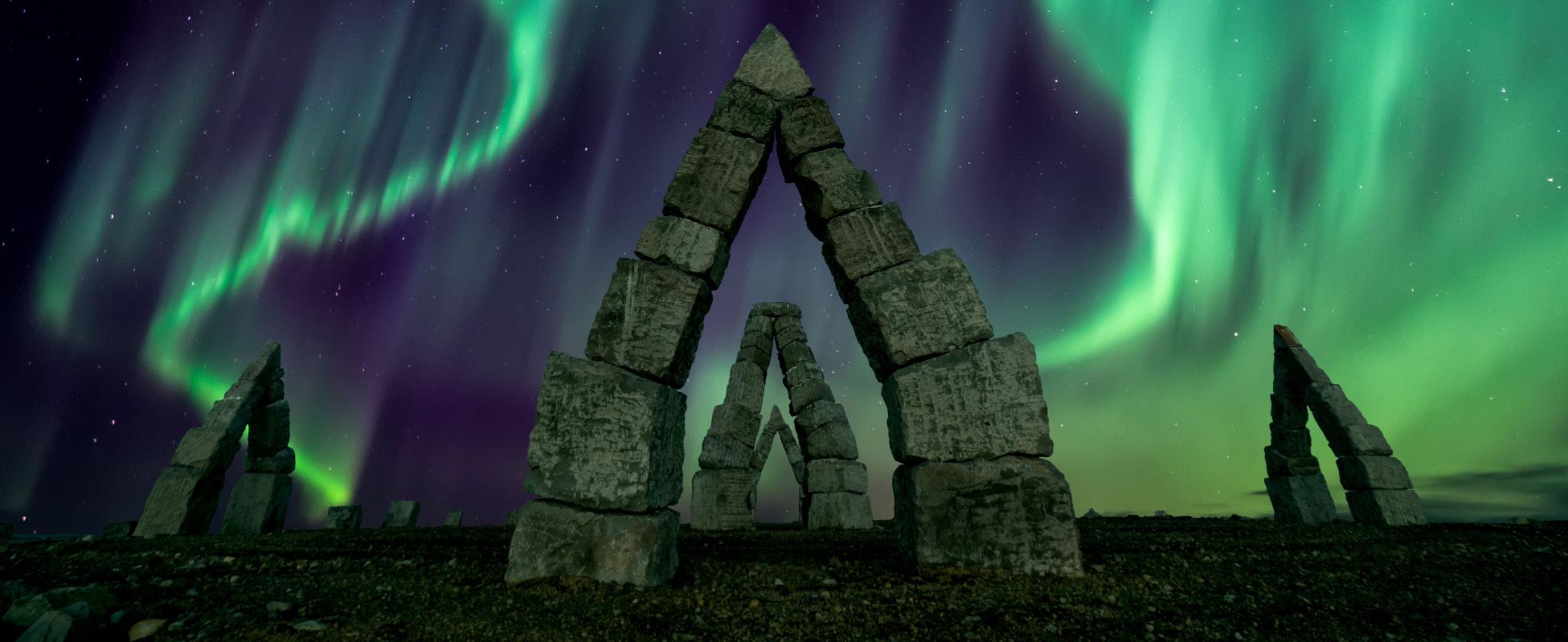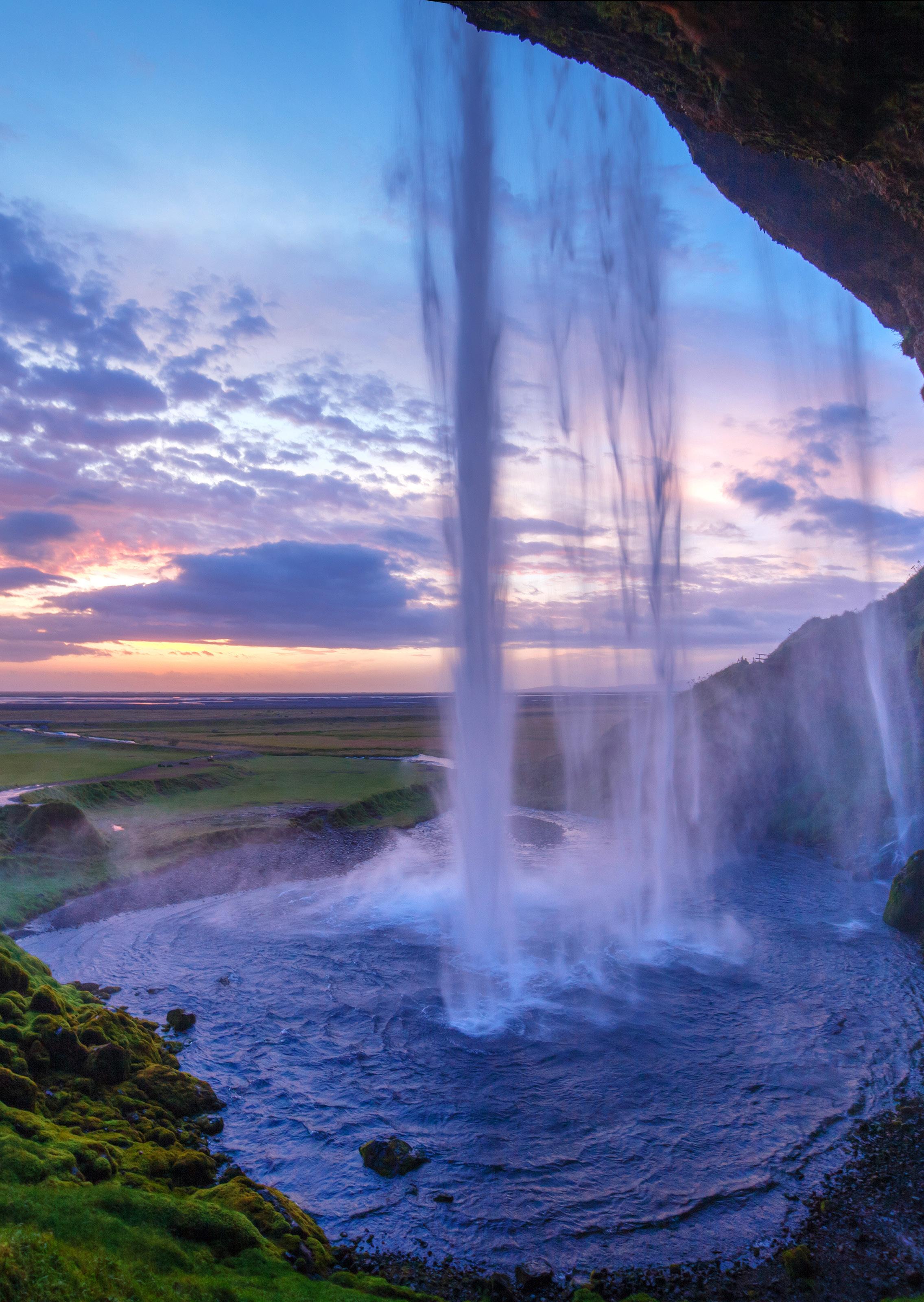
12 minute read
ROVING ICELAND’S GOLDEN CIRCLE
It’s just after midnight, June 21, 2016, and I’m standing on the street outside the Reykjavik pub from which I have just emerged. The sky above is clear and bright. Perhaps not as bright as when I went into the pub three hours ago but, then again, neither am I.
In the last 24 hours, I rafted (and swam) a glacial river, photographed a massive waterfall from dozens of angles, explored a terrain pitted with geysers and geothermal vents and walked between the European and North American tectonic plates, touching each continent. I had been off-roading through the lava fields. Best, I had been expertly schooled in Icelandic culture. As midnight approached, I stopped to enjoy the summer solstice with several bottles of the nicely hoppy local micro-brew, Úlfur India Pale Ale. I’m glad I did. I needed the break and – well, back off, I’m on vacation.
Later today, I will go whale watching in the harbor. Sleep is optional in Reykjavik.
Twenty-four hours of daylight are a pleasant resource in a land so oriented to being outdoors. The summers in Iceland are short, and the inhabitants make good use of every moment. Reykjavik has the unassuming look of a small town somewhere in Colorado more than it does a national capital. Yet, the essence of its Viking heritage is unavoidable and, unlike many of Europe’s larger cities, Reykjavik exudes a sense of place that leaves no doubt about its Scandinavian identity. The people who live here are as much a part of the land as the land is of them, there’s no separating the two.
“We all know each other,” my 25 year-old guide Robert Halldorsson, said to me as we left town earlier that morning on our drive. “We go to school together, socialize, we’re probably related! There are only 320,000 of us in the entire country after a thousand years, and two-thirds of them live in Reykjavik.” Like most here, Robert knows his Icelandic history and culture, and knows it well. Indeed, few cultures on the planet today are as homogenous as the native Icelanders. There has been very little immigration for more than 1,000 years when the first Vikings arrived, and nearly 80% of the population can trace their family histories back to the original settlers. No easy task considering there are no family names. Robert’s father had the first name of “Halldor” and Robert’s son will have the last name of “Robertsson”.
Better than 85% of the males on the island share a genetic make-up with modern day Norwegians. Interestingly, however, more than 60% of the females share genetics with modern women from Ireland and Scotland. “The Vikings left Norway alone and picked up their women along the way,” says Robert. Roving Iceland’s Golden Circle Travel Hippy

“They only took the pretty ones, as you can see.” He’s serious. “They left the ugly ones behind and the ones who got seasick, they threw off on the Faroe Islands along the way.” He grins at me broadly. “It’s true, you know.” Icelandic humor.
Robert is handling the four-wheel drive Toyota with oversized tires on these narrow roads with the ease of someone who has been doing this a long time and knows exactly where they are going. We round a turn in the road and the hillside across the valley is pockmarked with a dozen or more steaming thermal vents. The ground is alive, breathing, exhaling steam as the glacial water table hits the near surface magma. A t-shirt in a window-front in Reykjavik says simply “Ash happens”.
Iceland’s cultural and genetic markers are well known. They are among the largest people on the planet, and some of the most attractive. Robert is tall, with a ruddy complexion and blondish–red hair and beard. Having been a former Boy Scout in Iceland, he has spent many years backpacking the most remote corners of the island.
Robert’s lightly accented English is near perfect. Like many Icelanders, he speaks his native tongue, Danish, English and often another thrown in for good measure. The literacy rate in Iceland is the highest in the world at over 99%. Almost 10% of the population authors a book during their lifetime. Although only 25, Robert has just returned from Alaska where he undertook filming a documentary about Mount McKinley. Iceland is apparently a nation of very easy-going overachievers.
We are traveling today a part of Iceland’s Golden Circle. If you have 24 hours of daylight and want to get out into the countryside, this is an easy and accessible way to do it. Many enterprising travelers rent a vehicle and self-drive the 190 mile route that glances off many of Western Iceland’s most famous landmarks. A first timer, however, I’ve decided to take a guided tour both for the efficiency and for the lessons in Icelandic culture and nature Robert provides. The temperature on this last day of spring is a balmy 50 degrees Fahrenheit.
Coat or warm sweater not optional. We touch on a lot of topics during our drive, and Robert’s pride in Iceland is evident. Iceland represents the first and longest existing parliament government, formed in 930 AD. In the year 999 AD, the country peacefully, though under some force of threat, transitioned to Christianity from the old Norse religion
– Odin, Thor and the rest of the Asgard pantheon. The state church now is Lutheran, but Robert says he’s not been to church in a very, very long time.
“It’s like a hat” he said. “You wear it when you need to. Weddings, funerals, that sort of thing.”
Robert points to a small group of Icelandic horses standing in a field by the highway. Sturdy and broad across the back, their coats are still shaggy from the colder winter weather. “They are amazing animals. Unlike most horses, they have five gaits, not the usual four. They developed the extra gate for stepping across the lava fields. ” I ask about native wild animals, but apparently there’s only the artic fox and field mice, along with the birds, fish and whales.
By the way, in Iceland both whales and horses can find their way onto the dinner plate in many restaurants, a testament to the earlier scarcities of native land animals to feed the population. Robert and I discuss whaling only briefly as we are pretty clearly on differing sides of the issue.
Robert says whale tastes like steak. There are not many trees either. The once expansive forests of Iceland are now gone, the victim of exploitation by humans and the impact of successive volcano eruptions through the centuries. Much of the topsoil disappeared as well and attempts to re-forest with birches are evident everywhere along the way. Groves of birch trees spring up around clusters of summer homes in the country.
Icelandic joke: What do you do if you get lost in an Icelandic forest? Answer: Stand up.
Leaving out of Reykjavik, we head east toward the rafting base camp on the Hvítá (pronounced: Kveetau) River. The word “Hvítá” means “white”, so named for the fine ash and mineral sediment that color the glacial waters from which it flows.
“How cold is the water?” I ask Robert, half fearing the answer.
“It’s about 2 degrees, or so,” he says, “quiet warm.”
35.5 degrees Fahrenheit. It’s that Icelandic humor thing again.
We are the last to arrive at base camp. This section of the Hvítá is only a 2+ river, a very mild raft ride. The frigid waters, however, require a wet suit. The scenery along the way is both stark and beautiful, with the narrow river bounded on either side by 30-foot high walls of dark, volcanic stone.



At one point my rafting companions and I stop to jump into the river from the cliff face. I leap feet first, and the shocking chill of the water temporarily causes me to forget to begin swimming. It carries me quickly downstream for a few yards before I regain my senses and stroke for the banks and our raft. Once out of the water, however, the wetsuit does its trick and I’m no colder than before I jumped in.
Seven kilometers later, we are back at base camp, dried off and loaded into our Toyota for the short drive to Gullfoss, a waterfall of tremendous proportion on the same river I rafted moments before. More than 100 feet tall with twin cascades, Gullfoss is a force to witness. It is possible to walk out on rocks to the very edge, and there are dozens of excellent photography spots along the cliffs.
Approximately 11% of Iceland is covered by glaciers, and from the cliffs overlooking Gullfoss the Langjökull Glacier occupies much of the horizon. It is this glacier whose melting waters fill the Hvítá River. Today, we won’t be venturing onto Langjökull Glacier, but we will be traveling a short distance to see not a geyser, but the Geysir.
The Icelandic word geysir (“to gush”), from which the English word geyser is derived, is the name of one particular geyser. As we pull into the parking area, signs caution against trespassing too close to the geysers or treading across the lightly colored ground. Many hikers in the area have been badly burned when their feet broke through the clay surface into chambers of soil and water registering temperatures near boiling.
Stokkur, Geysir’s little brother, puts on a show for us. There is a deeply odd psychology to the anticipation of the geyser’s eruption. Suddenly the water in the caldron begins to mound then bursts forth, shooting a spray of sulphur water and steam in a column over the heads of the crowd gathered to watch. There is a visible joy on everyone’s face as the mist settles back to ground.
Iceland is situated directly atop the juncture of the North American and European tectonic plates, cutting through the middle of the island, slowly pulling apart at the rate of 2 centimetres per year. It is this geological phenomenon responsible for the country’s volcanic activity. In the year 930 AD, the early Icelanders chose a natural amphitheatre on this great rift between the two continental shelves to hold their first Althing, or parliament. A sheer cliff face on the eastern edge of the rift provided a dramatic acoustical backdrop where leaders were elected, laws developed and disputes settled. The waters that rise to the surface are both cobalt blue and clear, revealing a small fortune in coins tossed by visitors in homage to the mysterious power of the natural setting. Thingvellir National Park, home to the ancient Althing, sits next to Thingvallavatn, the largest natural lake in Iceland. In earliest times, the people would travel from the corners of Iceland to gather at Thingvellir. Its location and the necessity of cross-country travel prompted many of the real property laws of Iceland which allow free egress across private property by any person so long as no damage is done.
From Thingvellir, Robert pointed us back toward Reykjavik via unpaved back roads. We travelled through moss covered lava fields containing some of the impressive geo-thermal plants that power Iceland. These high-tech facilities are only lightly manned, sitting atop natural hot springs gathering steam that is piped into the countryside and cities alike to generate electricity, heat water and supply a clean source of power to the Icelanders. So abundant is the available supply, Reykjavik actually pumps hot water under city streets to keep them free of ice in the winter.
Dropping me off at the Holt Hotel, Robert provided a few restaurant suggestions that included the Sea Barron, owned by his uncle. I mentioned one other that had been recommended. “I hear many people eat there,” he said. “Mostly tourists.” I made a mental note to check out the Sea Barron.
Later that evening, I reflected on the 12 hours of sightseeing with Robert. It was a fine introduction to the countryside and culture, a way of seeing through to the heart of a destination in a way I had seldom experienced elsewhere.
I glanced at my watch, it was after midnight and the sun still hung high in the night-time sky. I ordered another Ulfar. Around me the city of Reykjavik was awake and alive.
I have a test for how successful any trip to a new destination might be, and seldom has any destination so completely satisfied the criteria.
Quite simply, I was exactly where I wanted to be.
About the Author: Travel Hippy Travel Hippy is a slightly road worn, cranky individual setting out to spend all of his children’s inheritence on travel. He is especially fond of the music, pubs and people of Northern Europe and Ireland, though he’s been spotted in Peru and Thailand as well.
Duration: 12 Days | Prices from: US $4,795
Cruise along the North Atlantic, exploring the Arctic landscapes of western Iceland and Greenland to discover Viking history and floating icebergs. From the cosmopolitan capital of Reykjavik, board the Ocean Diamond to cross the Denmark Strait to Greenland where you’ll follow in the footsteps of Erik the Red and survey the glaciers, fjords, and Inuit settlements that define this ancient island.

This 12-day tour takes you across the North Atlantic, from the Nordic landscape of Iceland to the glacial reaches of Greenland.
Your Icelandic tour begins in the capital of Reykjavik, a small city that boasts big culture. Take in the National Museum to learn about the nation’s founding or relax in the smoky hot springs that surround the town or sample its vibrant nightlife before taking to the sea aboard the Ocean Diamond. The Ocean Diamond is a modern super-yacht capable of carrying 189 passengers in maximum comfort across the ice-clogged seas of the North Atlantic. Relax in the charming common spaces, from the club lounge to the spacious restaurants, or spend your time on deck watching for dolphins or whales as you head towards Greenland.
Pass through the imposing Vestmannaeyjar or Westman Islands, jagged black rocks jutting out of the ocean. Land on inhabited Heimaey to spot the volcanoes, Eldfell and Helgafell, and witness half-buried houses from an eruption in the seventies. Cross the Denmark Strait that connects Iceland to Greenland, charting the course laid out by Vikings over 900 years ago. If you chance upon mild weather, pass through the Prins Christian Sound to cruise through a sea of icebergs. Reach land at the town of Narsarsuaq, very close to the settlement of Qassiarsuk, founded by Erik the Red. The green and verdant landscape around here inspired the name “Greenland,” even though the island as a whole is mostly snow-covered and desolate. Head up to the capital city of Nuuk to discover a cosmopolitan town set amongst a backdrop of snow-capped mountains and icy fjords. Visit the National Museum then pass onto Sisimut, where the island’s fishing industry thrives.









